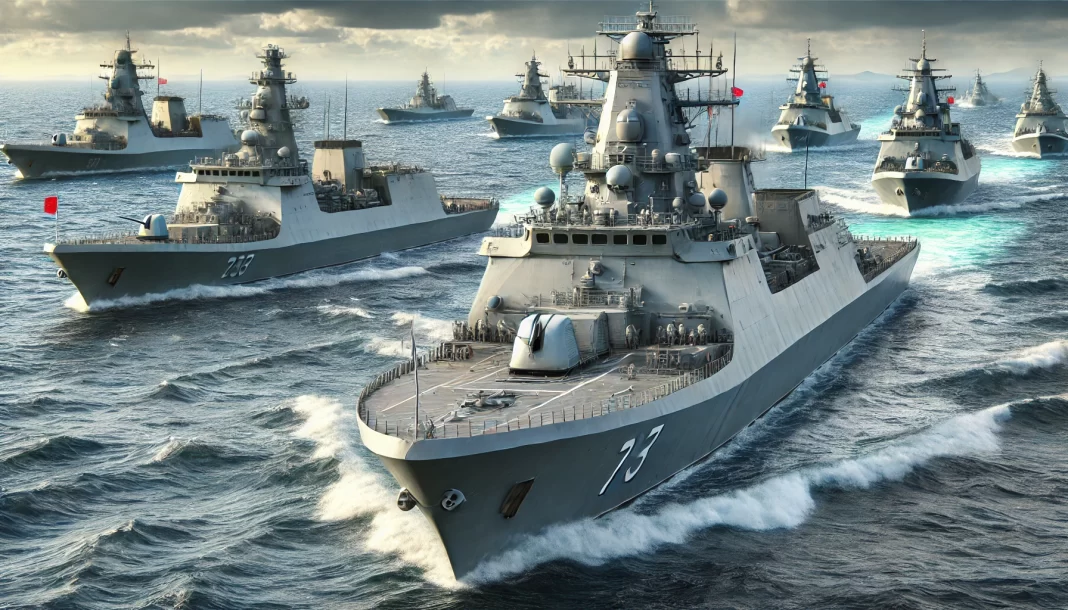For more than three weeks, Chinese warships have been moving around Australia’s coastline, coming as close as 200 miles to Sydney. This fleet includes the destroyer CNS Zunyi, the frigate CNS Hengyang, and the replenishment ship CNS Weishanhu. These ships have been navigating within Australia’s 200-nautical-mile Exclusive Economic Zone (EEZ). International law allows ships to move freely within this zone, but the Chinese fleet’s presence has caused concerns in Australia and New Zealand.
Chinese Destroyer and Frigate Near Australia
The Chinese vessels have been conducting live-fire exercises without giving any prior notice. Such military drills involve the use of real weapons and ammunition, which can pose risks to nearby areas. This activity has heightened tensions, as unexpected military exercises can lead to misunderstandings or conflicts. Australian naval ships like HMAS Stuart and HMAS Warramunga, along with surveillance aircraft, have been closely watching the Chinese fleet. The Australian Defence Force is gathering intelligence from these movements to understand China’s intentions and the nature of these exercises.
Australia’s coastline holds strategic importance due to its vast natural resources and critical industries. Western Australia, in particular, is home to major mining operations and energy production facilities. The presence of Chinese warships so close to these vital regions has prompted calls from Australian leaders to deploy more warships in the area to strengthen security. The Australian government is treating this situation seriously, as protecting the country’s economic interests is a top priority.
Strategic Impact in the Pacific Region
China’s naval operations are not limited to Australia. Similar activities have been noticed near Vietnam and Taiwan. The Chinese navy, which is now the largest in the world by hull count, has been increasing its presence across the Pacific region. This expansion challenges the security structure led by the United States and its allies.
Vietnam has reported increased sightings of Chinese naval vessels and destroyers near its waters, which are rich in natural resources. These activities have added to the ongoing territorial disputes in the South China Sea. China claims a large portion of this region, leading to tensions with countries like Vietnam and the Philippines. Chinese military ships and aircraft have also been seen conducting operations near Taiwan, further raising concerns among neighbouring countries.
Russia and Vietnam Strengthen Nuclear Energy Partnership
China has defended its actions, stating that it is normal for a major power to send naval vessels to different parts of the region. However, many countries view these operations as part of a larger strategy to expand China’s influence and challenge the existing balance of power. The Chinese navy’s increasing activity is seen as a test of how far regional countries are willing to resist its growing presence.
Shifting Alliances and Security Concerns
The presence of Chinese warships with destroyer and a frigate comes at a time when many countries are questioning the reliability of the United States as a security partner. The recent suspension of US military aid to Ukraine has raised doubts about whether the US would remain committed to regional security in the Indo-Pacific. If the US can withdraw support from Ukraine, some countries fear it might adopt a similar approach in the Pacific region.
Australia is relying on the AUKUS partnership with the US and the UK to strengthen its military capabilities. This agreement involves the purchase of nuclear-powered submarines, which would significantly enhance Australia’s naval strength. However, uncertainties about the US commitment to the agreement have added to Australia’s security concerns.
Japan and South Korea are also closely watching the situation. Both countries are long-standing allies of the US and play key roles in the Indo-Pacific region. Japan has reported increased Chinese naval activity near its waters, while South Korea is wary of any shift in US priorities. These countries are considering how best to protect their own security interests amid changing alliances.
In Taiwan, Chinese military operations have intensified, with several aircraft and naval vessels crossing the median line of the Taiwan Strait. Taiwan’s military remains on alert as tensions continue to rise. The Chinese navy’s actions are seen as part of a broader strategy to assert control over the region.
The ongoing presence of Chinese warships in the South Pacific is testing the resolve of countries in the region. It highlights the shifting balance of power and the need for countries to carefully assess their security strategies in response to China’s expanding influence.

